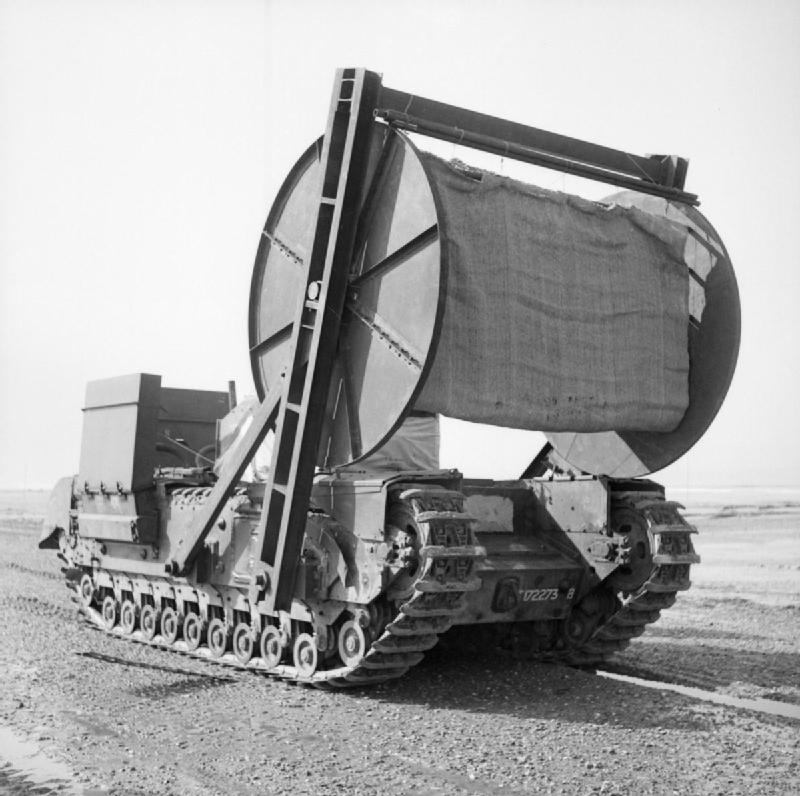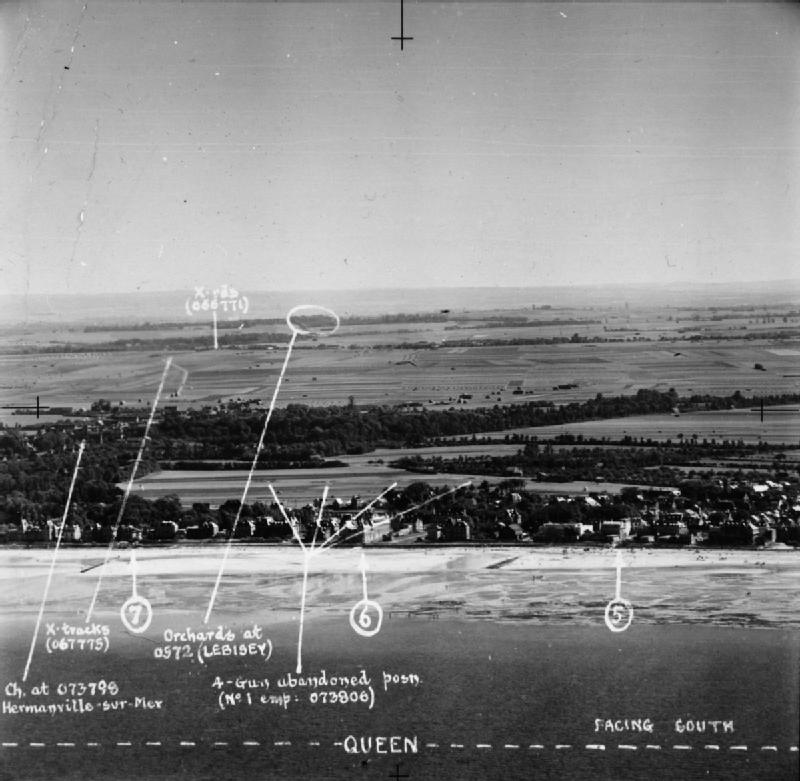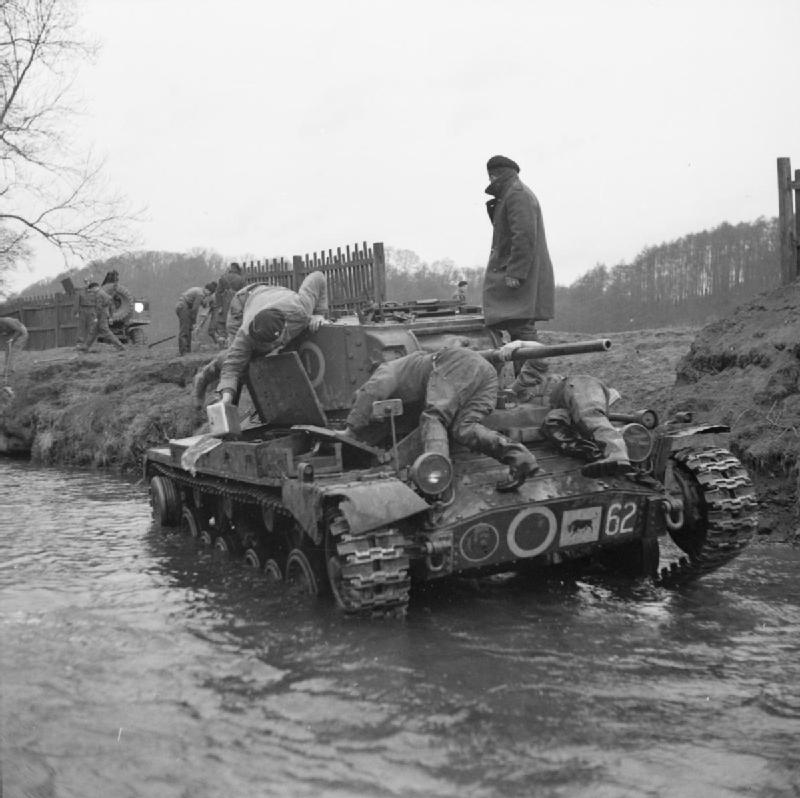|
1st Assault Brigade Royal Engineers
The 1st Assault Brigade Royal Engineers was a specialised armoured formation of the British Army active in the Second World War. It was formed in mid-1943 and its structure was three assault regiments of the Royal Engineers. It was assigned to the 79th Armoured Division in preparation for the Normandy invasion of 6 June 1944. The unit comprised armoured vehicles modified for specialist roles (also known as Hobart's Funnies), intended to assist with the landing phase of the operation. History By the end of October 1943, various engineer units had been renamed and transferred into the Brigade. This brigade comprised 3 Assault Regiments, each with 4 Assault Squadrons, plus an Assault Park Squadron. This structure remained unchanged up to the Normandy landings in June 1944. The basic vehicle of the assault unit was the Assault Vehicle Royal Engineers (AVREs). This was a Churchill tank with its turret modified or removed and to which were attached certain special equipments. ... [...More Info...] [...Related Items...] OR: [Wikipedia] [Google] [Baidu] |
British Army
The British Army is the principal land warfare force of the United Kingdom, a part of the British Armed Forces along with the Royal Navy and the Royal Air Force. , the British Army comprises 79,380 regular full-time personnel, 4,090 Gurkhas, and 28,330 volunteer reserve personnel. The modern British Army traces back to 1707, with antecedents in the English Army and Scots Army that were created during the Restoration in 1660. The term ''British Army'' was adopted in 1707 after the Acts of Union between England and Scotland. Members of the British Army swear allegiance to the monarch as their commander-in-chief, but the Bill of Rights of 1689 and Claim of Right Act 1689 require parliamentary consent for the Crown to maintain a peacetime standing army. Therefore, Parliament approves the army by passing an Armed Forces Act at least once every five years. The army is administered by the Ministry of Defence and commanded by the Chief of the General Staff. The British ... [...More Info...] [...Related Items...] OR: [Wikipedia] [Google] [Baidu] |
Sword Beach
Sword, commonly known as Sword Beach, was the code name given to one of the five main landing areas along the Normandy coast during the initial assault phase, Operation Neptune, of Operation Overlord. The Allied invasion of German-occupied France commenced on 6 June 1944. Stretching from Ouistreham to Saint-Aubin-sur-Mer, the beach proved to be the easternmost landing site of the invasion after the abortion of an attack on a sixth beach, code-named Band. Taking Sword was to be the responsibility of the British Army with sea transport, mine sweeping and a naval bombardment force provided by the British Royal Navy as well as elements from the Polish, Norwegian and other Allied navies. Among the five beaches of the operation, Sword is the nearest to Caen, about from the goal of the 3rd Infantry Division. The landings were achieved with low Allied casualties but the advance from the beach was slowed by traffic congestion and resistance in defended areas behind the beach. Fur ... [...More Info...] [...Related Items...] OR: [Wikipedia] [Google] [Baidu] |
Units Of The Royal Engineers
This is a list of units of the British Army's Royal Engineers. Groups Division * 1 * 2nd Armoured Division Engineer Regiment 23 Engr Regt and 25 Engr Regt amalgamated to form 2 Armd Div Engr Regt, September 1976. Based at Roberts Barracks, Osnabruck, served two tours in Northern Ireland; redesignated 25 Engineer Regiment in 1982. * 4 * 7 Armoured Establishment * 1 Engineer Training became 21 Field Engineer Regiment Brigades & Groups * 8th Engineer Brigade **12 (Force Support) Engineer Group ***28 Engineer Regiment (United Kingdom) (Counter-Chemical, biological, radiological and nuclear defence) *** 32 Engineer Regiment *** 36 Engineer Regiment (Force Support) *** 39 Engineer Regiment (Air Support) *** 71 Engineer Regiment (paired with 39 Regiment) *** 75 Engineer Regiment (paired with 36 Regiment) ** 29 (Explosive Ordnance Disposal & Search) Engineer Group ***29 Explosive Ordnance Disposal and Search Group Support Unit ***33 Engineer Regiment (EOD) *** 35 Engineer Regi ... [...More Info...] [...Related Items...] OR: [Wikipedia] [Google] [Baidu] |
Armoured Brigades Of The British Army In World War II
Armour (British English) or armor (American English; see spelling differences) is a covering used to protect an object, individual, or vehicle from physical injury or damage, especially direct contact weapons or projectiles during combat, or from a potentially dangerous environment or activity (e.g. cycling, construction sites, etc.). Personal armour is used to protect soldiers and war animals. Vehicle armour is used on warships, armoured fighting vehicles, and some mostly ground attack combat aircraft. A second use of the term ''armour'' describes armoured forces, armoured weapons, and their role in combat. After the development of armoured warfare, tanks and mechanised infantry and their combat formations came to be referred to collectively as "armour". Etymology The word "armour" began to appear in the Middle Ages as a derivative of Old French. It is dated from 1297 as a "mail, defensive covering worn in combat". The word originates from the Old French , itself derive ... [...More Info...] [...Related Items...] OR: [Wikipedia] [Google] [Baidu] |
List Of British Brigades Of The Second World War
This is a list of British Brigades in the Second World War. It is intended as a central place to access resources about formations of brigade size that served in the British Army during the Second World War. * List of British airborne brigades of the Second World War (includes airlanding and parachute brigades) * List of British anti-aircraft brigades of the Second World War * List of British infantry brigades of the Second World War (1–100) * List of British infantry brigades of the Second World War (101–308 and named) * List of British mobile brigades during the Second World War (includes armoured, cavalry, armoured reconnaissance, motor machine gun, support groups, and tank brigades) * List of British special service brigades of the Second World War See also * British Army during the Second World War At the start of 1939, the British Army was, as it traditionally always had been, a small volunteer professional army. At the beginning of the Second World War on ... [...More Info...] [...Related Items...] OR: [Wikipedia] [Google] [Baidu] |
British Armoured Formations Of World War II
During the Second World War the British Army deployed armoured divisions and independent armoured and tank brigades. Background During the interwar period, the British Army examined the lessons learnt from the First World War; and a need was seen for experimentation with and development of theories of manoeuvre and armoured warfare, as well as the creation of the short-lived Experimental Mechanized Force. The long-term impact was for the army to start to move towards mechanisation, to enhance battlefield mobility. By the 1930s, the army had established three types of divisions: the infantry division, the mobile division (later called an armoured division), and the motor division (a motorised infantry division). The primary role of the infantry division was to penetrate the enemy's defensive line, with the support of infantry tanks. Any gap created would then be exploited by mobile divisions, and the territory thus captured would be secured by the fast-moving motor divisions. ... [...More Info...] [...Related Items...] OR: [Wikipedia] [Google] [Baidu] |
Lieutenant Colonel
Lieutenant colonel ( , ) is a rank of commissioned officers in the armies, most marine forces and some air forces of the world, above a major and below a colonel. Several police forces in the United States use the rank of lieutenant colonel. The rank of lieutenant colonel is often shortened to simply "colonel" in conversation and in unofficial correspondence. Sometimes, the term 'half-colonel' is used in casual conversation in the British Army. In the United States Air Force, the term 'light bird' or 'light bird colonel' (as opposed to a 'full bird colonel') is an acceptable casual reference to the rank but is never used directly towards the rank holder. A lieutenant colonel is typically in charge of a battalion or regiment in the army. The following articles deal with the rank of lieutenant colonel: * Lieutenant-colonel (Canada) * Lieutenant colonel (Eastern Europe) * Lieutenant colonel (Turkey) * Lieutenant colonel (Sri Lanka) * Lieutenant colonel (United Kingdom) * ... [...More Info...] [...Related Items...] OR: [Wikipedia] [Google] [Baidu] |
Brigadier
Brigadier is a military rank, the seniority of which depends on the country. In some countries, it is a senior rank above colonel, equivalent to a brigadier general or commodore, typically commanding a brigade of several thousand soldiers. In other countries, it is a non-commissioned rank. Origins and history The word and rank of "Brigadier" originates from France. In the French Army, the Brigadier des Armées du Roi (Brigadier of the King's Armies) was a general officer rank, created in 1657. It was an intermediate between the rank of Mestre de camp and that of Maréchal de camp. The rank was first created in the cavalry at the instigation of Marshal Turenne on June 8, 1657, then in the infantry on March 17, 1668, and in the dragoons on April 15, 1672. In peacetime, the brigadier commanded his regiment and, in maneuvers or in wartime, he commanded two or three - or even four - regiments combined to form a brigade (including his own, but later the rank was also awarde ... [...More Info...] [...Related Items...] OR: [Wikipedia] [Google] [Baidu] |
AVLB
An armoured vehicle-launched bridge (AVLB) is a combat support vehicle, sometimes regarded as a subtype of military engineering vehicle, designed to assist militaries in rapidly deploying tanks and other armoured fighting vehicles across gap-type obstacles, such as (and primarily) rivers. The AVLB is usually a tracked vehicle converted from a tank chassis to carry a folding metal bridge instead of weapons. The AVLB's job is to allow armoured or infantry units to cross craters, anti-tank ditches, blown bridges, railroad cuts, canals, rivers and ravines), when a river too deep for vehicles to wade through is reached, and no bridge is conveniently located (or sufficiently sturdy, a substantial concern when moving 60-ton tanks). The bridge layer unfolds and launches its cargo, providing a ready-made bridge across the obstacle in only minutes. Once the span has been put in place, the AVLB vehicle detaches from the bridge, and moves aside to allow traffic to pass. Once all of the ve ... [...More Info...] [...Related Items...] OR: [Wikipedia] [Google] [Baidu] |
D-day - British Forces During The Invasion Of Normandy 6 June 1944 B5040
The Normandy landings were the landing operations and associated airborne operations on Tuesday, 6 June 1944 of the Allied invasion of Normandy in Operation Overlord during World War II. Codenamed Operation Neptune and often referred to as D-Day, it was the largest seaborne invasion in history. The operation began the liberation of France (and later western Europe) and laid the foundations of the Allied victory on the Western Front. Planning for the operation began in 1943. In the months leading up to the invasion, the Allies conducted a substantial military deception, codenamed Operation Bodyguard, to mislead the Germans as to the date and location of the main Allied landings. The weather on D-Day was far from ideal, and the operation had to be delayed 24 hours; a further postponement would have meant a delay of at least two weeks, as the invasion planners had requirements for the phase of the moon, the tides, and the time of day that meant only a few days each month were ... [...More Info...] [...Related Items...] OR: [Wikipedia] [Google] [Baidu] |
D-day - British Forces During The Invasion Of Normandy 6 June 1944 B5095
The Normandy landings were the landing operations and associated airborne operations on Tuesday, 6 June 1944 of the Allied invasion of Normandy in Operation Overlord during World War II. Codenamed Operation Neptune and often referred to as D-Day, it was the largest seaborne invasion in history. The operation began the liberation of France (and later western Europe) and laid the foundations of the Allied victory on the Western Front. Planning for the operation began in 1943. In the months leading up to the invasion, the Allies conducted a substantial military deception, codenamed Operation Bodyguard, to mislead the Germans as to the date and location of the main Allied landings. The weather on D-Day was far from ideal, and the operation had to be delayed 24 hours; a further postponement would have meant a delay of at least two weeks, as the invasion planners had requirements for the phase of the moon, the tides, and the time of day that meant only a few days each month were ... [...More Info...] [...Related Items...] OR: [Wikipedia] [Google] [Baidu] |
30th Armoured Brigade
The 30th Armoured Brigade was an armoured formation of the British Army that served in Western Front (World War II)#1944–1945: The Second Front, Western Europe Campaign as part of the 79th Armoured Division (United Kingdom), 79th Armoured Division. After the reformation of the Territorial Army in 1947, the brigade was re-created within the Territorials based in Scotland and finally disbanded by 1967. Second World War Service The 30th Armoured Brigade was created on 27 December 1940 as part of Northern Command (United Kingdom), Northern Command. It was initially formed from the 2nd Battalion, The Queen's Westminsters, a motorized infantry unit, which was joined by a cavalry unit, the 23rd Hussars, three days later, on 30 December. Just over a week later, on 8 January 1941, the 23rd Hussars were replaced by the 22nd Dragoons, and on 28 January the brigade was transferred to Western Command (United Kingdom), Western Command. On 8 March the brigade was augmented with the addi ... [...More Info...] [...Related Items...] OR: [Wikipedia] [Google] [Baidu] |



.jpg)



